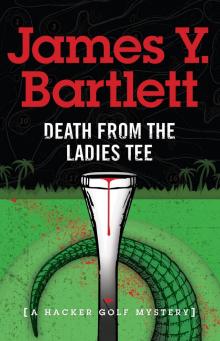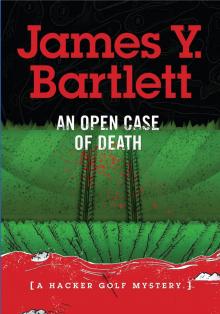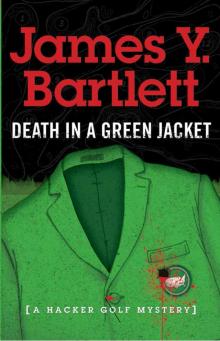- Home
- James Y. Bartlett
Death from the Ladies Tee Page 2
Death from the Ladies Tee Read online
Page 2
"Yoo-hoo, Peter!" she chirruped from the doorway. "I find myself in need of a corkscrew. Have you one handy?"
The yoo-hoo got me. So did the Peter. No one called me Peter. But so did the sudden clarity with which I saw my predicament. The two glasses were the tip-off. My corkscrew would lead to her offer of a neighborly sherry in thanks. And then two or three more. She would be liberal with the refilling. That would lead to slightly slurred words, batted eyes, casual caress, shy giggles and a sudden, more meaningful glance. There would be a sudden attack with her hot, slack mouth, hoping that the three, or was it four?, sherries would have broken down any remaining resistance and inhibition. There would be a frantic shedding of clothes, the rapid unveiling of that knobbly body with her broad shoulders and sharp angles and its pale white of desperation. But after three, or was it four?, sherries, who cares? And then would come the rushing, gasping, frantic chase, faster and harder. Bony hips digging into thighs. Release, oblivion, collapse. Until the morning, or an hour or so later, when the time would come to sort out the emotions and determine the question of what's next in the cold and harsh light of daybreak.
And even if I were able to somehow avoid that scenario tonight, tomorrow would bring another attack, a different strategy, a ratcheting up of the siege.
"Honie," I said into the phone, "I've changed my mind. Miami sounds great. I'll be down tomorrow afternoon."
"Oh, Hacker. . .thanks!" she exclaimed. "You are a prince! There's a flight from Boston at two that gets in at five-thirty. Ill meet you."
I thought about this for a second. "How did you know what time the flights were?" I wondered. "That's . . .that's . . ." I cast about for just the right epithet to hurl at her across the telephone.
"Professional," she said. "Very professional."
CHAPTER THREE
On the plane ride down to Miami the next afternoon, I thought about the LPGA. It was true that the ladies’ game did not receive the same attention as the men’s. Except for the one week each summer when the women played a tournament in greater Boston, and another week when the U.S. Golf Association held their national Open for women, news about women’s golf was buried deep inside the Journal’s sports pages, right next to the bowling league scores.
Something didn’t add up. The women’s professional tour had been around since the 1940s, and there had been a steady progression of excellent women players over the years: Babe Didrickson, Patty Berg, Mickey Wright, Kathy Whitworth, JoAnne Carner, Wynnona Stilwell, and in recent years, Nancy Lopez, Pat Bradley, Betsy King, Beth Daniel, Patty Sheehan, Annika Sorenstam and many others.
So it certainly wasn’t a lack of marquee names that held the tour back as a successful enterprise. Nor did it seem the tour was lacking a fan base. I had recently read some statistics that showed the numbers of women golfers in the United States had reached more than twenty-five percent of the total and was climbing steadily every year. I knew from personal experience that more and more women were playing the game. You saw them everywhere. And they had won important battles for equality at private clubs all across the country.
But the LPGA continued to struggle, year after year. Struggled for tournament sponsors, struggled to fill up every week with another event, struggled for face time on TV. Even the men’s senior tour, made up of fat, paunchy and graying men well past their prime, had been organized out of nowhere and rocketed to success. The old guys had no trouble finding sponsors, filling weekends and getting TV time. It didn’t seem fair, somehow.
Why was the LPGA having so much trouble attracting attention and dollars? The modern era of the tour had been plagued by a series of terrible leaders whose mismanagement had saddled the organization with some heavy credibility problems among the powers-that-be, both at the network and corporate levels. And it was widely believed that women professionals, even on shortened courses, don’t make enough birdies to satisfy a rabid fan. This, I knew, was a subjective opinion, but held more than a grain of truth. While women pros have beautiful swings and all the abilities and shotmaking skills, they do not usually perform with the same kind of bravura, knock-down-the-pins attitudes witnessed every weekend on the men’s tour. At least, that’s the common perception. And it needs to be overcome.
Further, I mused as the plane throbbed its way south over an unending bank of blue-gray clouds, the current women’s tour had not developed a lot of distinctive personalities at the top. I cringed in my seat as imaginary shrews began shrieking protests at me. What about Betsy King? they yelled. What about Annika? Nancy Lopez? Karrie Webb? How can you say such a thing?
I could say it because it was true. Nancy Lopez had certainly excited lots of attention in her heyday, especially 1978, the year she won five tournaments in a row. But these days, with three kids in tow, Nancy’s best golf is behind her. Betsy King? A dominating player for a while, but as exciting to watch as a Swiss cheese. Annika has certainly perked up the impressions people have of women golfers, and deservedly so, but who competes with her? Karrie Webb did for a while, and then faded. And Webb fell into the category of women golfers who are certainly accomplished golfers, but whose personalities and appearance don’t seem to appeal to an admittedly sexist American sporting public. It’s the Anna Kournakova syndrome: If you look gorgeous, attention will follow you, even if you can’t play a lick. But you can be a worldbeater, and if you’re a bit zaftig or if you play with a scowl or if you don’t resemble the perennial girl next door, no one will care. Unfair? Unquestionably. Fixable? Probably not in this lifetime.
And, of course, the LPGA had what we all euphemistically called the “image problem.” There had always been whispering about the “image problem.” Some of my more cynical golf writer associates had a different phrase: “dykes in spikes.”
Also unfair, the LPGA had long battled the perception that most of its players were lesbians. No one that I know had ever taken a survey, and the LPGA’s own press manual did not list the sexual inclinations of the players. But whenever the subject of the LPGA came up, in boozy late-night bar conversations, or in coded references in published stories, the lesbian thing always came up. We writers often gossiped or exchanged info on what we’d heard. That the winner of three major tournaments whose constant travel companion always gets a decidedly nonsisterly smooch after every good round. The leading money winner who likes to cruise the leather bars in each city she visits. The new, younger players who get treated like “fresh meat” by the older, experienced pros.
I had listened to, laughed at, and clucked over all these stories over the years. And while it never particularly mattered to me who was sleeping with whom, it figured that some element of homophobia figured into the LPGA’s problems. They had always tried to promote their good-looking players – like Laura Baugh and Jan Stevenson – while keeping some of the more mannish types well under wraps. It was grossly unfair, but the LPGA had to market itself toward the heterosexual ideal: blond, good-looking and fresh. The PGA Tour didn’t have those problems. And it was generally assumed that all the male professionals were constantly fending off – or not – women everywhere they went. Another heterosexual ideal.
The shape and substance of my piece began to take some shape as I thought about these things. Perhaps I could send it over to our Sunday magazine, and made a mental note to contact that editor to talk it over with him. The readers of the Boston Journal’s sports pages are probably more comfortable with Red Sox box scores than with the sexual identity of the woman golfer.
Honie Carlton was waiting for me when I deplaned in the humidity of Miami. I almost didn’t recognize her. She had indeed grown up. The pert and cheerful little teenager I remembered had become a stunning young woman with all the requisite curves and shapes that entails. She was wearing a soft pink sleeveless top and a conservative but shapely white skirt. Her light brown hair was pulled back from her face and tied with a pink bow, and some cheerfully colored earri
ngs jiggled with the movement of her head. Her pale blue eyes were alight in her perfect face, soft round lips tinged with just the slightest shade of pink.
Like any other red-blooded American male, I felt my heart do a quick flip-flop as I studied her. But then I imagined what my mother would say to such thoughts, and quickly pushed them aside.
“Hacker!” she cried as she came running up and gave me a big hug. “Jeez, it’s so good to see you! Thanks so much for coming down.”
“God, child, you make me feel old before my time,” I said, slinging my leather carryall over my shoulder and trying not to walk stooped over. She frowned at me prettily.
“When people say things like that to me, it makes me feel like I’m fourteen and trying on my first training bra,” she pouted.
“You’re right,” I said. “I apologize. It’s always difficult for one generation to admit the next to all the privileges of adulthood.”
“Whoa,” she said. “That’s deep.” She giggled.
We made small talk as we collected my bags, walked outside into a thick vapor of humidity and piled into a cab. Miami is probably my least favorite city in probably my least favorite state. Never mind the constant heat that always saps whatever reserves of strength I have built up; never mind the little bugs that seem to find me, no matter how far indoors I take myself or how thickly I lather myself with dope; never mind that the golf courses—uniformly flat, watery and breezy—all seem to run together in my head after a while.
No, what I don’t like about Miami in particular and Florida in general, is the built-in isolation. There are no neighborhoods in Florida … only walled compounds. Except for the slums and barrios. There are no homes with yards in Miami, just impregnable villas surrounded by tall stucco walls and screened-in swimming pools. Miami, the sun-and-fun capital of the world, is really an indoor place: hidden, private, secret and usually off-limits. Air-conditioned and kept cool and dark. Protected by private cops in gatehouses, security patrols, angry dogs and DO NOT ENTER signs.
Maybe they’ve got it right and the rest of us are wrong. The world is a dangerous place. Carving out a private and hidden sanctuary and not letting anyone in without prior clearance is perhaps the best way to combat that danger. But as an outsider, Miami always makes me feel uneasy. A trespasser in paradise.
From the airport, our cab rode us past a few of those walled paradises and through a section of slum before pulling swiftly through the enormous stucco gate that marks the entrance to the Doral Golf Resort & Spa. We moved from the hot, simmering asphalt streets into a whisper-quiet, lushly landscaped tropical setting, with towering royal palms, expansively huge banana trees, flowering hibiscus and oleander, and acres of well-tended beds of coleus and marigolds. Fountains gushed from the center of lakes. A strong, athletic girl in a swimsuit of spun gold hurled herself from a high-dive platform into a sparkling pool. Tennis was being played by matrons dressed in crisp whites. And from the winding drive, I saw glimpses, too, of green and manicured fairways across which drove gold-colored golf carts whose roofs were fringed in white.
The cab pulled up to the imposing entrance lobby, where a tall and muscular black man, dressed in some absurd kind of English colonial military uniform, right down to the white pith helmet piped in gold braid, waved us to a stop. With military precision, he lifted my suitcase out of the trunk, waved the cab on and pointed the way to the registration desk.
“Welcome to the Doral,” he said. “Please enjoy your stay.”
He did not call me Bwana, which was a disappointment.
“Sim salla bim,” I said to him and handed him a couple of bucks.
“I beg your pardon?” he said. I noticed his gold-plated name tag said CARL. So much for colonial authenticity.
With Honie hovering about helpfully, I checked in. She had arranged a junior suite for me, which typically runs about $350 a night. The desk clerk passed over the registration form for me to sign. I noticed that in the block headed “Room Rate” it said “Complimentary, $0.00.” All hail the power of the press.
We were assigned a bellman and went back outside to collect my bag. Just as we reached the curb, a gigantic black limo pulled in. Do they make stretch Bentleys? This monster had rolling black fenders, some strange kind of sterling silver hood ornament, oversized whitewalls, glistening grillwork and tinted windows. It looked like it was twenty-five feet long.
I felt Honie come to attention beside me. Carl leaped to open the rear door and, with an extra flourish, extended his white-gloved hand inside to aid the passenger’s disembarkation.
Out of the car came Wynnona Haybrook Stilwell. She was one of the LPGA’s few instantly recognizable celebrities. Wyn Haybrook had been one of America’s finest amateur players as a teen. Tall, big-boned and rangy, she had carved an impressive path through the golf tournaments of her day. She had played a power game that few other women possessed. She could boom her driver miles down the fairway, hit crisp and precise iron shots and sink putts from anywhere. And it was as a youth that she got tagged with her nickname. It was the newspapers that created it. “Another Big Wyn for Haybrook.” “Big Wyn Does It Again.” “Ladies Open: A Big Wyn in a Rout.”
When she turned pro, Big Wyn kept on winning, both as Haybrook and later as Mrs. Stilwell. She was one of the Big Three in the women’s game, along with Kathy Whitworth and JoAnne Carner. It was the distaff version of Palmer, Nicklaus and Player.
While, as with the other two, her heyday had largely passed, she was still considered a dangerous golfer – always capable of throwing up a low number on any given day. And Big Wyn continued to dominate the ladies’ tour in other ways. For more than ten years, she had been president of the tour’s Player’s Association, and was a force in determining how the tour was operated. “Got to look after my girls,” she was always quoted as saying.
Big Wyn Stilwell looked more like the Queen Mother than a den mother as she emerged from the limo. She was still tall, but her girth had expanded some over the years. Still, she had an athletic build with broad and powerful-looking shoulders and strong-looking arms. Her skin was the deeply tanned shade of an outdoor person. Her once-golden hair had begun to lighten to gray and she wore it in a tight, short, manly cut, parted on one side.
Her face was the key to her celebrity. Its chiseled features were instantly recognizable. That defiant jut of her jaw, those flashing, angry-looking brown eyes, those strong lips pursed in furious concentration. That was the picture most of us had of Big Wyn as she marched determinedly down the fairway to yet another championship. Even here, on a hot, muggy sidewalk, one could look at BigWyn and hear the echoes of the cheers of the multitudes ringing softly in the breeze.
Once out of the limo, Big Wyn strode purposefully into the hotel without waiting for the rest of her party. Climbing out after her was a small, pale man, balding above the temples, nattily dressed in a dark charcoal suit with tie and matching pocket square. Emerging into the bright Florida sun, he squinted against the light and clutched a briefcase protectively against his chest.
“That’s Benton Bergmeister,” Honie whispered to me, identifying the commissioner of the LPGA Tour. Bergmeister caught sight of Big Wyn’s stern disappearing into the hotel and set out at a half-trot to catch up with her. It reminded me of the White Rabbit scurrying after the Queen of Hearts.
Last one out of the limo was one of those rare creatures – an honest-to-God, heart-in-the-throat, pulse-stopping, head-turning babe. Long, long legs unfolded out of the door, followed by a torso that had seemingly been poured into a shimmering, ice-blue dress that just barely accomplished the business of clothing. And the package was topped, as such a package should be, with faultless blond hair, high cheekbones, sharp blue eyes and pouty lips framed in a long, smooth face.
She emerged as if in slow motion from the limo and stood there a moment, smoothing down her dress over a
body that should have been illegal. Carl flashed her a silly smile and bowed. I had the feeling that the world around us was reacting as if in one of those brokerage house commercials. Birds stopped singing, insects stopped buzzing. The high diver froze in midair and golfers halted their swings halfway down.
I made some kind of strange, throaty groaning sound that came out in a rough approximation of “Whozzat?”
Honie sighed the sigh of a woman who knows she’s been licked and knows there’s not a damn thing she can ever do about it. The package in the ice-blue dress was that good.
“That’s Casey Carlyle,” she told me resignedly. “She’s Big Wyn’s, ummm, secretary.”
I had to start breathing through my nose. My throat was suddenly rendered inoperable.
Honie looked at me with no small measure of disgust. “Calm down, Hacker,” she muttered. “You’ll get to meet her in person tonight when you meet Big Wyn. I’ve got you scheduled for cocktails in Wyn’s suite at seven. Casey’ll be there.”
“Eeeep,” I managed.
“But I gotta warn you,” she added. “Better men than you have tried and perished with that one. She’s reputed to be a real ball-breaker.”
“Aaarrp,” I squeaked.
Honie sighed again, deeply, took my arm and dragged me off to find my hotel room.
CHAPTER FOUR
Honie left me alone to kill a leisurely hour or so wandering around the grounds of the famed Doral, a place I visited every March for the men’s tournament staged on the resort’s famed Blue Monster course. A monster it is, too, long and winding and tightly guarded on all sides by sand and water. When the wind is up, it’s a great test for the pros, but for mere mortal golfers, it can be so difficult as to stop being fun to play.
But the resort has three other courses, all named after a color. The LPGA would be playing on the Old White, east of the main hotel. Meanwhile, the resort’s guests could still play the Blue Monster, or the Red or Gold courses, both of which were similar in topography, but surrounded by south Florida housing: tightly packed homes protected by walls. As at many resorts in this modern age of commerce, Doral’s big bucks come from conventions and business meetings more than Mom and Pop vacationers. As I wandered around the busy courses in late afternoon, I saw fleets of golf carts set up to handle the crush of business executives who tomorrow would leave a morning seminar and head out en masse to one of the courses for an afternoon of forced sociability. One of Hacker’s Rules of Golf, the firmest, is “Never play behind a businessperson’s golf group. Instead, head for the nearest bar.” This is because most of those forced to play in those afternoon rounds are, at best, twice-a-year golfers who hit the ball sideways with everything up to and usually including the putter. It makes for an excruciating round of golf.

 P.G.A. Spells Death
P.G.A. Spells Death Death from the Ladies Tee
Death from the Ladies Tee An Open Case of Death
An Open Case of Death Death is a Two-Stroke Penalty
Death is a Two-Stroke Penalty Death in a Green Jacket
Death in a Green Jacket Death at the Member Guest
Death at the Member Guest